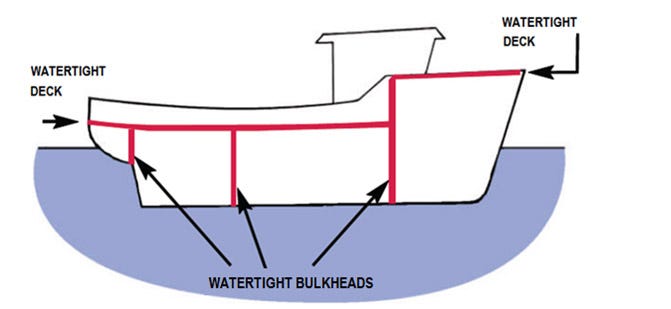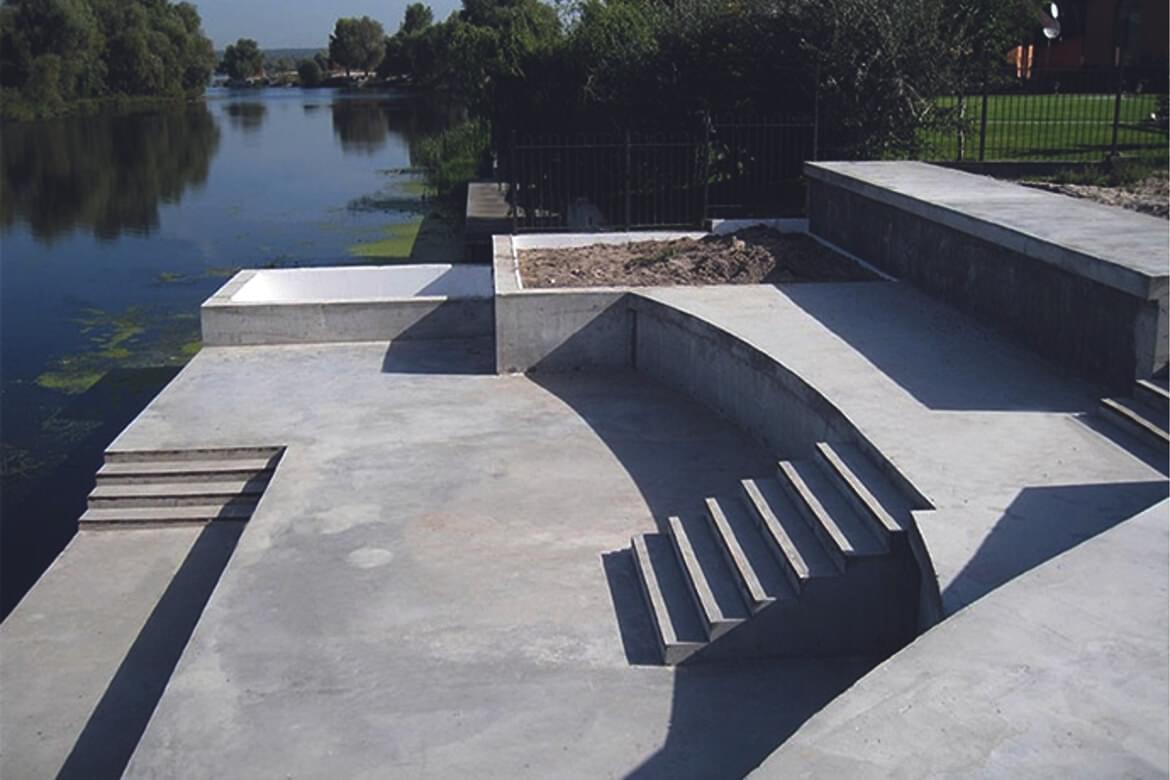Bulkhead on Lake Livingston in Public Architecture: What You Must Learn
Wiki Article
Discovering the Various Usages of Bulkhead Frameworks in Modern Architecture
Bulkhead frameworks play a significant duty in modern-day design, offering both functional and visual objectives. They can specify areas, improve storage solutions, and improve lighting. In industrial settings, they serve as centerpieces that mirror brand identity - Bulkhead on Lake Livingston. In addition, their assimilation often sustains audio monitoring and sustainable practices. Recognizing the complete extent of their applications discloses much about modern design trends and customer experience. What ingenious usages of bulkheads might arise in the future?Specifying Bulkhead Structures
Bulkhead structures play an essential function in modern design, acting as important components in various structure designs. These frameworks are normally defined as elevated platforms or ceilings, often made use of to hide mechanical systems, electrical wiring, or plumbing. Bulkheads can be located in both residential and business setups, where they supply a seamless mix of functionality and visual appeals. Their design can incorporate lighting fixtures and various other attractive components, enhancing the general aesthetic allure of an area.Normally built from products such as steel, drywall, or wood, bulkheads can be customized to fit the architectural style and requirements of the structure (Bulkhead on Lake Livingston). They serve not only to conceal unattractive framework however additionally to produce specified zones within open rooms. By managing the circulation of a space, bulkheads add to the spatial organization, making them a considerable facet of modern building practice. Their meaning encapsulates both visual and practical dimensions.
Useful Applications in Residential Layout
Bulkhead structures play a crucial duty in domestic design by assisting in room optimization methods that maximize functional locations. In addition, they add visual layout components that enhance the visual allure of living areas. Additionally, these frameworks provide important architectural assistance remedies, guaranteeing the stability and safety and security of the home.Space Optimization Strategies
As modern domestic designs significantly focus on effective use area, ingenious approaches emerge to optimize capability without giving up visual appeals. One prominent strategy involves the integration of bulkhead frameworks, which can mark locations while offering vital storage space remedies. These structures can be utilized to develop upright storage space units that enhance both company and ease of access. Additionally, multi-functional furnishings, such as exchangeable sofas and foldable tables, enhances bulkhead designs, permitting rooms to adjust to varying requirements. Open up layout even more optimize spatial circulation, urging flexibility being used. Including integrated shelving and recessed illumination within bulkheads also adds to a structured setting, ensuring that fully of space is made use of successfully and harmoniously within the general layout.Visual Layout Elements

Architectural Assistance Solutions
In contemporary property style, a reliable architectural support solution is crucial for preserving the stability of spaces while optimizing format and performance. Bulkhead structures play a considerable duty in this circumstance, functioning as both support and partitioning aspects. They can conceal mechanical systems, such as pipes and electrical circuitry, while supplying reinforcement to the ceiling and flooring systems. By tactically positioning bulkheads, engineers can produce specified areas within open floor plans, improving use without jeopardizing architectural stability. In addition, these structures can accommodate lights components, adding to both aesthetic appeals and practicality. To sum up, bulkhead structures are vital in residential design, offering flexible assistance options that improve both the capability and visual allure of living spaces.Enhancing Aesthetic Appeals in Commercial Areas
When industrial areas embrace innovative bulkhead frameworks, they not only specify physical boundaries however additionally greatly improve the overall aesthetic appeals of the setting. These building components work as visual prime focus, attracting attention and creating a feeling of intrigue. By incorporating varied materials such as timber, metal, or glass, bulkheads can show a brand name's identification and goal, adding to a natural design.The strategic placement of bulkheads can manipulate light and darkness, including deepness and measurement to otherwise flat areas. This interaction can change an industrial location into a welcoming atmosphere, encouraging consumer involvement. Furthermore, the use of color and texture in bulkhead design can stimulate certain emotions, boosting the general customer experience. Inevitably, the thoughtful assimilation of bulkhead structures boosts the visual allure of commercial areas, making them not only functional but also visually captivating, therefore promoting an enduring perception on visitors.
Acoustic Performance and Audio Monitoring
Efficient acoustic efficiency plays an essential role in modern style, particularly within business spaces where audio administration is important. Bulkhead structures can substantially boost acoustic high qualities by taking in audio, decreasing echo, and mitigating noise transfer in between areas. These functions are specifically helpful in environments such as workplaces, restaurants, and cinemas, where clear interaction and a positive auditory experience are link vital.The calculated positioning and design of bulkheads can assist produce sound-buffer zones, effectively separating noisy locations from quieter ones. Materials used in bulkhead construction, such as acoustic panels and soft finishes, add to their sound-dampening capabilities. In addition, the unification of bulkheads permits the combination of sound-absorbing aspects without compromising aesthetic allure. By attending to acoustic efficiency, architects can produce unified settings that enhance comfort, boost individual experience, and advertise performance, making bulkheads an essential component in the style of modern commercial spaces.
Integrating Bulkheads for Efficient Area Utilization
Although frequently ignored, the assimilation of bulkheads in architectural design can considerably improve space use in modern structures. These architectural components serve several practical functions, offering a method to hide mechanical systems, electric circuitry, and plumbing without compromising appearances. By strategically placing bulkheads, designers can develop defined areas within open layout, thereby facilitating better organization and circulation.Additionally, bulkheads can integrate storage solutions and lights attributes, visit our website optimizing the functionality of otherwise wasted vertical area. In domestic settings, they may delineate areas such as kitchens or living locations, while in business areas, they can boost the efficiency of layouts by plainly noting pathways and workplace.
Eventually, the thoughtful assimilation of bulkheads adds to an extra visually enticing and organized environment, enabling versatile spaces that can advance with the demands of their passengers. This technique not just maximizes space however likewise promotes an extra harmonious interaction in between kind and function.
Bulkheads in Public Architecture

Building Aesthetic Enhancements
While numerous building components go for functionality, bulkheads in public design serve a dual purpose by boosting visual allure. These frameworks often create aesthetic passion via their style, integrating effortlessly with surrounding aspects. By employing various products, textures, and shades, bulkheads can add to an one-of-a-kind identification for public rooms, such as airport terminals, galleries, and collections. Their tactical positioning assists to define locations, assisting visitors while adding deepness to the total layout. Additionally, bulkheads can accentuate lighting, producing vibrant environments that change throughout the day. This aesthetic improvement not only elevates the site visitor experience but also promotes a sense of place, making bulkheads a vital factor to consider in modern public architecture. In general, bulkheads personify the blend of kind and function.
Structural Support Solutions
As engineers seek cutting-edge ways to boost the architectural stability of public rooms, Source bulkheads emerge as necessary parts in the design and building and construction process. These frameworks give important support, particularly in locations subject to hefty foot web traffic or dynamic tons. By dispersing weight equally, bulkheads aid stop structural failure while allowing for versatile style alternatives. In big locations, such as stadiums and convention facilities, bulkheads are often incorporated into the general architectural structure, making certain stability and security. Furthermore, they can assist in the consolidation of utilities and mechanical systems, adding to the efficiency of area use. Ultimately, bulkheads stand for a critical service in modern-day public style, enhancing both capability and protection in community-focused settings.Environmental Security Actions
Incorporating ecological security measures into public design has actually become significantly crucial as metropolitan developers focus on sustainability along with structural support. Bulkhead frameworks serve a double purpose hereof, working as obstacles versus disintegration and flooding while all at once boosting the visual appeal of city landscapes. Their design commonly includes all-natural elements such as plants, which can boost air top quality and supply habitats for wild animals. In addition, bulkheads can be engineered with permeable products that permit water absorption, lowering overflow and advertising groundwater recharge. This integration of ecological considerations not just protects the environment yet likewise fosters area durability against environment modification. By utilizing bulkheads efficiently, engineers add to sustainable urban development that aligns with contemporary ecological goals.Future Fads in Bulkhead Style
Emerging trends in bulkhead layout reflect a growing focus on sustainability, innovation, and performance in modern architecture. Developers are increasingly incorporating green products, such as recycled composites and bioplastics, to decrease ecological impact. On top of that, the assimilation of smart technology is coming to be widespread, allowing bulkheads to offer multi-functional purposes, including power storage space and environment control.
In city setups, modular bulkhead systems are acquiring traction, supplying versatility in style and ease of setup. These systems can be adjusted to various landscapes, allowing for efficient area utilization. Additionally, visual considerations are progressing; bulkheads are now being made to improve visual appeal, frequently incorporating artistic aspects that resonate with neighborhood culture.
As climate strength comes to be a priority, future bulkhead designs will likely focus on flooding protection and stormwater management, ensuring structural honesty while resolving environmental difficulties. This change symbolizes an alternative technique to style that meets both human needs and eco-friendly responsibilities.
Often Asked Inquiries
What Materials Are Typically Used for Bulkhead Building?
Usual materials for bulkhead building and construction include concrete, steel, hardwood, and composite products. These alternatives provide longevity, structural integrity, and resistance to ecological variables, making them ideal for numerous applications in building and engineering tasks.How Do Bulkheads Affect Structure Power Performance?
Bulkheads boost building power effectiveness by supplying thermal insulation and reducing air leak (Bulkhead on Lake Livingston). They aid preserve indoor temperature levels, consequently decreasing heating and cooling down needs, eventually bring about lower energy prices and boosted environmental sustainabilityAre There Any Kind Of Building Regulations Particular to Bulkhead Structures?
Yes, constructing codes specific to bulkhead frameworks exist, differing by location. These guidelines generally resolve security, structural integrity, and accessibility, making certain that bulkheads fulfill required criteria for building and style within a given jurisdiction.Can Bulkheads Be Easily Modified or Eliminated Later On?
Bulkheads can often be customized or removed, depending upon their design and building and construction. Nonetheless, such modifications may require cautious preparation and adherence to building ordinance to ensure architectural integrity and safety are maintained throughout the process.What Are the Prices Associated With Setting Up Bulkhead Structures?
The expenses connected with setting up bulkhead structures can differ substantially, typically affected by materials, design intricacy, and labor. Normally, expenditures vary from moderate to high, relying on the task's details requirements and area.Bulkhead frameworks play a crucial duty in modern design, serving as essential components in different structure layouts. Bulkhead frameworks play a necessary duty in household style by promoting area optimization strategies that make best use of functional locations. Commonly forgotten, the combination of bulkheads in building design can significantly boost area usage in contemporary buildings. As engineers seek cutting-edge means to boost the structural integrity of public spaces, bulkheads emerge as crucial elements in the layout and construction procedure. The costs linked with setting up bulkhead structures can differ considerably, typically affected by materials, layout complexity, and labor.
Report this wiki page